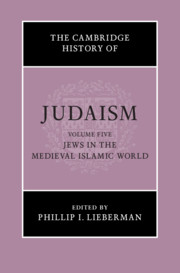Book contents
- The Cambridge History of Judaism
- The Cambridge History of Judaism
- The Cambridge History of Judaism
- Copyright page
- Contents
- Figures
- Acknowledgments
- Introduction
- Part I Jews in the Medieval Islamic World
- A. The Islamic World in the Middle Ages
- B. Regional Surveys
- Chapter 4 The Maghrib and Egypt
- Chapter 5 The Jews of Muslim Spain
- Chapter 6 Beyond Crescent and Cross
- Chapter 7 Yemen and India from the rise of Islam to 1500
- Chapter 8 The Jews of Northern Arabia in Early Islam
- Chapter 9 Judaism in Pre-Islamic Arabia
- Chapter 10 The Islamic East
- Part II Social and Institutional History
- Part III Spiritual and Intellectual History
- Index
- References
Chapter 10 - The Islamic East
from B. - Regional Surveys
Published online by Cambridge University Press: 21 August 2021
- The Cambridge History of Judaism
- The Cambridge History of Judaism
- The Cambridge History of Judaism
- Copyright page
- Contents
- Figures
- Acknowledgments
- Introduction
- Part I Jews in the Medieval Islamic World
- A. The Islamic World in the Middle Ages
- B. Regional Surveys
- Chapter 4 The Maghrib and Egypt
- Chapter 5 The Jews of Muslim Spain
- Chapter 6 Beyond Crescent and Cross
- Chapter 7 Yemen and India from the rise of Islam to 1500
- Chapter 8 The Jews of Northern Arabia in Early Islam
- Chapter 9 Judaism in Pre-Islamic Arabia
- Chapter 10 The Islamic East
- Part II Social and Institutional History
- Part III Spiritual and Intellectual History
- Index
- References
Summary
The present chapter concerns the Jewish inhabitants of the vast area stretching from modern Iran in the west to China in the east, and from the Central Asian steppes in the north to the shores of the Persian Gulf in the south. Most of the chapter is dedicated to the Jews of the Iranian world, namely, the territories which were historically inhabited by Iranian-speaking peoples, from the advent of Islam up to the rise of the Safavids in the early sixteenth century. I conclude this chapter with the history of Jewish presence in territories historically ruled by Chinese dynasties, as most of the sources relating to Jews in this part of the world indicate their possible Iranian origin.
- Type
- Chapter
- Information
- The Cambridge History of Judaism , pp. 332 - 368Publisher: Cambridge University PressPrint publication year: 2021
References
Primary Sources
Secondary Sources
- 1
- Cited by

